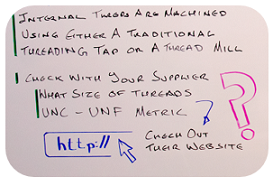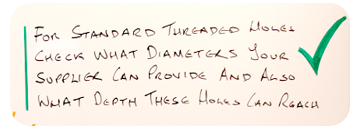
CNC Threading – For Milled and Turned Parts
Your masterclass in product design and development
Protolabs’ Insight video series
Our Insight video series will help you master digital manufacturing.
Every Friday we’ll post a new video – each one giving you a deeper Insight into how to design better parts. We’ll cover specific topics such as choosing the right 3D printing material, optimising your design for CNC machining, surface finishes for moulded parts, and much more besides.
So join us and don’t miss out.
Insight: CNC Threading – For Milled And Turned Parts
Hi and welcome to this week’s Insight video for Friday.
Just to remind you that these videos are here to help you master digital manufacturing. Whether you need parts or prototypes from 3D printing, injection moulding or CNC machining, they are packed full of practical tips to help you get it right.
This week we are looking at CNC threading for milled and turned parts and what is possible and what is not.
Let’s start by looking at what’s typically available.
At its simplest level there are two basic types of machined threads, internal and external.

Internal threads are machined using either a traditional threading tap or a thread mill. We think you are better off using a thread mill because it offers more flexibility and you can adjust the hole size. This reduces the cost of tooling and time since you don’t need to change it.
It also means that you can design custom threads without having to invest in custom taps.
Threading for milled parts can be in one of the three cardinal axes, whereas for turning it needs to be perpendicular to the axis of revolution.
There are also a few other things that you should check with your supplier.
First what size of threads in UNC, UNF and metric do they supply? Check out their website it may be on there.

You also need to check the maximum depths for the threads that they can offer. If they are using a thread mill then the depth will increase as the diameter of the threads increase, but more on that later.
Internal threads are also available on turned parts. You will find that many of the same rules apply for machining threads using live tooling on a lathe, but the threads available are more limited than with milling.
Okay back to the depth of a threaded hole. If you need a hole that is longer than your supplier can do at that diameter, you still have some options.

First select the hole from the side that the screw will be started from. If you need the screw to pass all the way through the part, then you can pass a tap through the hole in a secondary process to complete it.
You can also select both sides of the feature to be threaded as you can see in image 2. You do however risk the threads being cross threaded as they come from opposite sides. But as long as the threads don’t intersect, then selecting threads from both sides is okay.
Okay let’s take a quick look at external threads.
If your parts qualify for turning, then generally there should not be any issues.
External milled threads are far less common than internal threads, but they can still be machined. Check that your supplier has this capability. They are produced on the half diameter and then turned around 180 degrees to machine the other side.
This works well for larger coarser threads, but you may need to chase the threads to remove any remaining material or mismatch as the threads are produced in two different machining set ups.
Smaller external threads are more difficult to produce and you will have to chase the threads with a thread cutting die to remove any material left behind.
So, to recap, for standard threaded holes check what diameters your supplier can provide and also what depth these holes can reach.

Similarly for external threads it’s worth checking what outer diameter threads are possible and the maximum thread depth that they can achieve for both turned and milled parts.
As with all digital manufacturing thinking through the function of the final part and what role the internal or external thread will play could influence your design.
There are occasions when you might need an insert to be added into the threaded hole for additional functionality.
For example, coil inserts will provide stronger threads. They need to be added after the manufacturing.

Similarly key inserts are ideal for thread reinforcement especially if the mating stud or bolt is going to be removed frequently.
Check what your supplier provides in terms of inserts and also how they affect both the hole diameter and depth.
I’m going to finish off by saying that many CAD packages allow you to display threaded features in different ways. It is a good idea to check with your supplier how these features should be presented and in what file format.
Okay that’s it for this week. I know there’s quite a lot of information to take in in this video and also the others that we have done. To find out more take a look at our website where we have produced a number of written practical design tips and guides to help you out.
Until next time.
With special thanks to Natalie Constable.










